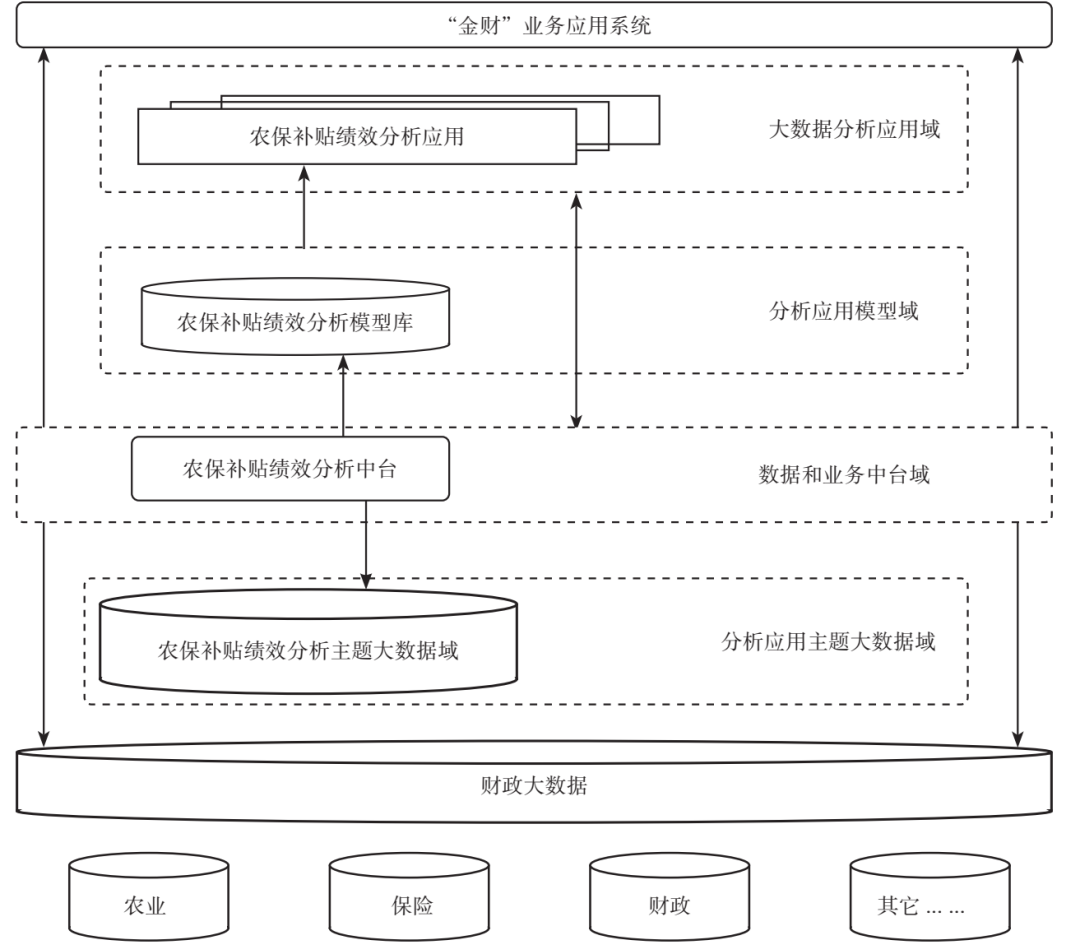内容提要:本文基于大数据构建了农业保险保费补贴的绩效评价体系,提出了评价业务需求指标到大数据体系三种形态的转变,针对传统评价权重的困境,可以通过线性组合向非线性组合的拓展、大数据空间下评估相对绩效水平等做法进行改进,同时也为异质性项目提供了统一的处理方法。在此基础之上,论文通过多层次大数据域、数据和业务中台域等关键组成,从应用框架的角度进一步落实了评价体系的实施,并通过跨部门大数据共享机制与区块链技术、特征提取与人工智能技术、经验积累与知识图谱技术等新技术应用对核心难点进行了阐述。最后还提出了整体的规划、试点安排、激励等相应的制度建议与思考。
一、引言
农业保险保费补贴是财政支持农业的重要举措,为了充分发挥财政资金效应,自2011年起,我国选取四川和内蒙古开展种植业保险保费补贴绩效评价试点工作。绩效评价工作开展以来,已经取得了不少成绩,但还存在着一些问题,例如,缺少统一数据库作为评价工作的基础,现有的具体评价指标并非“数据驱动”,不同地区、不同农业产品补贴存在差异,统一评价的科学统筹还有待改进,并且需要解决不同角度、不同主体的绩效评价目标的综合问题。针对这些问题,大数据或许提供了解决的思路,而这一方法的运用也正是目前财政绩效管理改革的发展趋势和方向。
2018年9月,《中共中央国务院关于全面实施预算绩效管理的意见》正式发布,明确要求预算绩效评价指标建设需要“依托大数据分析技术”,2019年5月,财政部发布了《关于推进财政大数据应用的实施意见》,要求各部门推进财政大数据应用,以支撑建立现代化财政制度,这也是第一次从顶层设计层面对财政大数据的应用做出要求,其中也明确提出预算绩效管理大数据应用。对于发展十多年的农业保险保费财政补贴涉及的数据量而言,应用大数据建设绩效评价体系已经具备相当基础,正当其时。
In September 2018, the opinion of the Central State Council of the Communist Party of China on the full implementation of budget performance management was officially published, explicitly requiring the construction of budget performance indicators to be “based on big data analysis techniques” and, in May 2019, the Ministry of Finance issued an implementation opinion on the promotion of large-scale fiscal data applications, requiring departments to promote large-scale financial data applications to support the establishment of a modern financial system. For the first time, the application of large-scale fiscal data was required from the top-level design level, with clear indications of large-scale data applications for budget performance management.
二、农保补贴绩效评价的体系构建
(一)评价业务需求在大数据体系中的实现
根据《财政部关于印发<预算绩效评价共性指标体系框架>的通知》(财预[2013]53号)、《财政部关于印发<财政支出绩效评价管理暂行办法>的通知》(财预[2011]285号)及《财政部关于进一步推进中央部门预算项目支出绩效评价试点工作的通知》(财预[2009]390号)等相关文件规定,从共性指标来看,项目评价的共性指标共20个。在共性指标指导下,各级部门结合具体情况,针对农保补贴的评价进行了进一步的设计。从目前来看,不同级次的农保补贴的评价指标体系基本围绕决策、实施、效果和可持续四个维度,分别设置一级指标、二级指标和三级指标进行评价。一是决策,主要评价决策必要性和决策科学性情况;二是实施,主要围绕政策实施中的关键环节开展评价;三是效果,主要评价该项政策产生的经济效益、社会效益以及资金效率等情况;四是可持续,主要评价国内和国际政策环境对政策可持续发展的影响。另外,根据《关于规范绩效评价结果等级划分标准的通知》(财预便[2017]44号)要求,三级指标评价结果都需要按等级划分为四个档次。
According to the relevant documents of the Ministry of Finance on the publication of < the framework for a common system of indicators for the evaluation of budget performance & gt; circulars (fiscal forecast [2013] 53), Ministry of Finance on the issuance & & lt; interim scheme for the management of the evaluation of agricultural expenditure performance & gt; circulars (fiscal forecast [2011] 285) and Ministry of Finance circulars on the further development of pilot projects for the evaluation of expenditure performance of central sector budgets (fiscal forecast [2009] 390), a total of 20 common indicators for the evaluation of projects are provided in terms of common indicators. Under the guidance of common indicators, the evaluation of agricultural subsidies at all levels has been further designed in the light of specific circumstances.
(二)大数据驱动下的评价权重确定
1.传统评价权重确定的困境
1. The dilemma of traditional evaluation weights
由于评价主要针对围绕财政补贴运作的相关因素(指标),而影响评价目标的却不仅仅是补贴相关的财政因素因此确定系数(或权重)的传统方法可能存在评价偏差。例如就农业生产效率提升的目标来看,至少有农业生产的技术因素、自然因素、市场因素等发挥作用,在特定情况下,这些因素可能产生最主要的影响,而使得财政补贴的影响不显著,造成评价的偏差。加之,在通过数据推算权重的情况下由于样本有限,甚至有偏,往往使得所确定的系数适应性较差。其实,评价实践中通常使用经验确定权重而不采取数据驱动方式,这是为了避免更大的错误而采取的无奈之举。大数据为这一传统做法的改进提供了契机。
For example, the traditional method of determining coefficients (or weights) may be biased, since the evaluation focuses primarily on the relevant factors (indicators) surrounding the operation of financial subsidies, while the objectives of the evaluation are not limited to those related to subsidies. For example, in terms of the objective of increasing the efficiency of agricultural production, at least the technical factors, natural factors, market factors, etc., play a role that, in a given case, may have the most significant impact, leaving the impact of financial subsidies less visible and leading to deviations in the evaluation.
2.基于大数据的改进
2. Improvements based on big data
一方面,基于大数据可以将更多的变量纳入评价体系,在财政补贴之外,找到更多能够科学评价的潜在变量。另一方面,更值得期待的是,由于大数据的支持,更多模型和方法的引入对科学确定权重提供了支持。
On the one hand, large data can incorporate more variables into the evaluation system and, beyond financial subsidies, identify more potential variables that can be scientifically evaluated. On the other hand, it is all the more desirable to see that the introduction of more models and methods supports scientific weightings, thanks to the support of big data.
(三)大数据空间下异质性补贴项目的处理
(iii) Treatment of Heterosexual Subsidies under Large Data Spaces
在前述分析中,缺省的假设是补贴绩效评价项目之间具有可比性,是同质的,而事实上,由于项目处于不同的社会经济环境中,甚至于项目本身补贴对象及促进目标具有不可比性,因此项目之间存在异质性现象。例如,同类项目不同地区、不同项目同一地区、不同项目不同地区,这些情况下较大概率会存在着异质性的现象。对于该问题,如果观察或分析发现显著的异质性存在。
In the preceding analysis, the default assumption is that there is comparability and homogeneity between subsidy performance evaluation projects, whereas, in fact, there is a heterogeneity between projects because of their different socio-economic circumstances and even the fact that the project itself subsidizes the target and promotes the objective. For example, there is a heterogeneity in different regions of the same project, in different regions of the project and in different areas of the project. In this case, if observations or analyses reveal significant heterogeneity, there is a heterogeneity.
消除异质性现象的做法一般如下:第一,在实务当中,可以通过所谓的“一级指标、二级指标、…N级指标”的做法来完成,这一做法实际上是“数据、指标、模型”三种状态的灵活应用,在更低一级的指标中反映项目的特殊性,在更高一级的指标中进行一般化处理,即通过三层之间的转换解决绩效评价项目的异质性和统一性矛盾。第二,这种处理方式,可以用更统一的模型来表述。
The approach to the elimination of heterogeneous phenomena is generally as follows: first, in practice, it can be achieved through the so-called “first-level, second-tier,.N-level” approach, which is in fact a flexible application of the three states of “data, indicators, models” reflecting the specificity of the project in lower-level indicators, and generalization in higher-level indicators, i.e., resolving the heterogeneity and uniformity of performance evaluation projects through a three-tier shift. Second, this approach can be expressed in a more uniform model.
三、农保补贴绩效评价大数据应用框架
(一)应用框架及其重要组成
1.应用框架与评价体系
1. Application framework and evaluation system
大数据分析应用框架不仅需要将前述评价理论体系讨论的业务需求进行落实,而且需要系统性考虑与现有财政信息化业务的结合。如表1所示,评价体系业务框架中涉及的核心数据,与应用框架的重要组成部分分别对应。要结合大数据生命周期不同阶段的特点,将评价指标的采集数据、分析指标和计算模型等三种形态分别通过财政大数据、主题大数据域、分析应用模型域进行存放,如图1所示,通过数据和业务中台域实现三种形态的转换操作、权重ai(βi)及模型f(Xi)的确定等关键操作,通过大数据分析应用域实现具体的绩效评价业务需求,并与现有的“金财”业务应用系统交互。
The broad data analysis application framework requires not only the implementation of the operational needs discussed in the above-mentioned evaluation theory system, but also systematic consideration of integration with existing financial information operations. As shown in table 1, the core data involved in the operational framework of the evaluation system correspond to the key components of the application framework.
表1 评价体系与应用框架主要对应关系


图1 基于大数据的农保补贴绩效评价应用框架
农保补贴绩效评价应用框架的重要组成部分涉及面向绩效评价应用的多层次大数据域、支撑数据形态转化和权重确定的数据和业务中台域等,分别从静态和动态的两个角度支撑绩效评价大数据应用的实施。
An important component of the application framework for performance evaluation of agricultural subsidies relates to multiple layers of large data fields for performance evaluation applications, data supporting data morphological transformation and weight determination, and the medium-to-business domain, which underpins the implementation of large-scale data applications for performance evaluation from both static and dynamic perspectives, respectively.
2.面向农保补贴绩效评价应用的多层次大数据域
结合目前农业、保险、财政大数据的现状,多渠道收集整理用于农保补贴绩效评价大数据应用的基础数据、业务数据、行业数据等,全面建立多层次大数据域,为绩效评价奠定数据基础。
In the context of the current state of data on agriculture, insurance and finance, multiple channels for the collection and collation of basic data, operational data, industry data, etc. for large data applications for the evaluation of agricultural subsidies, and the full development of a multilayered, large data domain to provide a data base for performance evaluation.
农业生产统计与监测数据、农业保险及风险监控数据、财政数据是主要数据来源。农业生产统计与监测是绩效大数据评价的根基,既是决定农保补贴的产业基础,又反映补贴影响农业生产的效果和效益。农业保险及风险监控是绩效大数据评价的两翼之一,农业保险反映了其作为保险产品的一面,而风险监控是衡量农保补贴科学性的基础,在一定程度上也是补贴控制和防范化解风险的目的是否达到的基准参考点。而财政数据则是绩效评价的另一翼,是反映财政补贴运行的主要记录。层次分明、互相支撑的三个部分体现了从产业经济到财政、从补贴运用到效果的不同路线,有力地奠定了财政补贴分析主题大数据域的基础。
Agricultural production statistics and monitoring data, agricultural insurance and risk monitoring data, and fiscal data are the main sources of data. Agricultural production statistics and monitoring are the basis for the evaluation of large-scale performance data, both as the industrial basis for determining agricultural subsidies and reflecting the effects and benefits of subsidies affecting agricultural production.
分析主题域是面向农保补贴评价的大数据,其与财政大数据既有联系又有区别,联系是分析主题域来源于财政大数据,区别在于其是对财政大数据的进一步加工整理,分析指标和计算模型(结果)的存取是其主要特色,并且根据不同评价业务进行进一步的分类及管理,主题域的角度包括:基于农保补贴不同品种,基于宏观、中观和微观层次,基于立法、审计、社会公众多元视角,基“中央—省—市—县—乡”的财政层级,基于“经济发达地区—经济欠发达地区”不同区域,基于政府会计、中期财政规划、目标管理、平衡计分卡、绩效审计和第三方评价等不同方法,通过大数据主题域的建设,为绩效评价管理应用奠定数据基础。
The analysis of the subject area, which is large data for the evaluation of agricultural subsidies, is linked to and differentiated from large financial data. The link is between the analysis of the subject area, which is derived from large fiscal data, the difference being that it is a further processing of large financial data, the analysis of access to indicators and calculation models (outcomes) is a major feature, and is further classified and managed on the basis of different evaluation operations. The thematic area perspective includes: based on different varieties of agricultural subsidies, based on macro-, meso- and micro-levels, based on legislative, audit-, social-public diversity perspectives, the financial level based on “central-provincial-municipal-provincial-provincial” and based on different regions of “economicly developed areas — economically less developed areas”, and on different methods of government accounting, medium-term financial planning, target management, balanced scorecards, performance auditing and third-party evaluation, which provide a data base for the application of performance evaluation management through the construction of large data subject areas.
依托多层次大数据域,针对具体的农保补贴绩效评价项目的典型数据收集过程一般是通过农业生产业务数据、保险数据、相关农业影响风险数据、财政补贴数据等主要数据源采集数据,然后按照以上多层次大数据域进行归集,为进一步的绩效指标计算奠定基础。
The typical data-collection process for specific agriculture subsidy performance evaluation projects, based on multilayered large data fields, is generally based on primary data sources such as agricultural production operations data, insurance data, relevant agricultural impact risk data, and fiscal subsidy data, which are then aggregated according to the above-mentioned multilayered large data domains to provide the basis for further performance indicator calculations.
3.支撑数据形态转化和权重确定的数据和业务中台域
3. Data and operations central domain supporting data morphological transformation and weight determination
数据和业务中台域承担了形态转换和权重确定的核心功能。伴随着大数据的积累,所谓“中台”是互联网企业在大数据实践中弥补传统前台应用和后台数据管理的功能不足提出的新概念和新方法(谭虎和陈晓勇,2019),数据和业务中台域实质是应对数据应用多样化需求的统一工具,对补贴绩效评价大数据分析进行探索也为这一方法论提供了实践机会。通过数据中台统一数据标准和口径,将底层的财政大数据加工成可用性更强的主题域大数据,为财政部门内外提供高效的大数据资产服务;通过业务中台将财政分析业务与分析逻辑进行隔离,提供通用化的各类分析服务和功能,向具体的分析业务提供能够快速、低成本、可复制的分析能力。
The core functions of morphology conversion and weight determination are performed in the data and operational domain. Along with the accumulation of large data, the so-called “middle table” is a new concept and approach that Internet enterprises have developed in large data practice to compensate for deficiencies in the functionality of traditional front-office applications and back-office data management (Tanhu and Chen Xiaoyong, 2019), the substance of the data and operations centre area is a unified tool to respond to the need for diversification of data applications, and the exploration of large data analysis for the evaluation of subsidized performance offers practical opportunities for this approach. By harmonizing data standards and calibres in the data centre, the lower-level financial data are processed into larger subject area data that are more readily available, providing high-impact data asset services both within and outside the financial sector; by separating financial analysis operations from analytical logic through the middle-office, providing various types of analytical services and functions that are universalized and providing analytical capabilities that can be quickly, low-cost and replicable to specific analytical operations.
(二)农保补贴绩效评价大数据应用的核心难点及新技术的应用
1.跨部门大数据共享机制与区块链技术
1. Cross-sectoral large data-sharing mechanisms and block chain technology
预算绩效管理改革的深入,必然形成各个部门、多个层次的大量预算绩效数据和信息,这些信息的有效共享是预算绩效管理改革成功的基础。在数据共享机制建立的制度基础之上,近些年出现的区块链技术是实现各部门之间信息共享的绝佳匹配技术。在基于大数据的农保补贴绩效评价体系建设中,鼓励探索适合多部门数据分享的应用模式,通过区块链技术提供的公开透明、多节点分享、不能篡改等特点,为解决预算执行部门、预算管理部门、第三方信息平台之间的有效信息传递和分享提供了新的技术解决思路,将可以进一步奠定大数据背景下绩效管理改革的扎实数据基础。
Building on the system established by the data-sharing mechanism, the block-chain technology that has emerged in recent years is an excellent matching technology for information-sharing across sectors. In the context of the development of a large-data-based system for evaluating the performance of farmers, the exploration of applications suitable for multisectoral data-sharing is encouraged, through the transparency, multi-point sharing and non-altering features provided by block-chain technologies, to provide new technical solutions to address effective information transfer and sharing between budget-execution departments, budget management and third-party information platforms, which will further lay a solid data base for performance management reform in the context of large data.
2.绩效评价特征的提取与人工智能技术
2. Performance evaluation features extraction and artificial intelligence technology
传统绩效管理评价的特征主要基于指标体系展开,其逻辑起点和支撑主要是来自于专家经验和实践积累,随着绩效管理的全面展开,动态复杂的管理实践使得传统技术急需改进和完善,人工智能技术的应用能够有效提升这一领域效能,一方面可以将人工智能技术用于在海量数据中提取和筛选有效绩效指标,以获得更加科学反映绩效管理特征的指标集及相应权重,另一方面更为重要,即在越来越多的项目文档中,可以探索自然语言处理技术(NLP),在项目文本中进行语义分析和特征抽取,深度挖掘绩效评价的有效要素,更好地奠定绩效管理的模型基础。
Traditional performance management evaluations are characterized primarily by a system of indicators based on which the logical starting point and underpinnings are derived mainly from the accumulation of expert experience and practice. As performance management is fully developed, dynamic and complex management practices make it possible to improve and refine traditional technologies, and the application of artificial intelligence technologies can effectively enhance the effectiveness of this area by, on the one hand, using artificial intelligence technologies to extract and filter performance indicators in big data to obtain a more scientifically representative set of indicators and corresponding weights of performance management features, and, on the other hand, more and more importantly, exploring natural language processing techniques (NLPs) in a growing number of project files, undertaking semantic analysis and feature extractions in project texts, deepening the effective elements of performance evaluation and better laying the model basis for performance management.
3.绩效评价的经验积累与知识图谱技术
3. Experience-building and knowledge mapping techniques for performance evaluation
绩效评价是需要不断交互提升的领域,有效解决经验和知识积累是可持续发展的核心和关键。知识图谱作为相应的技术方案,将有助于这一问题的解决。绩效管理领域知识图谱的构建实质是绩效管理智能化的过程,是面向未来智能时代的前沿性问题。要基于绩效管理的大数据体系和应用实践,对绩效管理领域知识结构进行分析,形成绩效管理概念体系,逐级展开进行绩效管理知识元建设,探索和确定绩效管理领域实体间关系和属性,实现语义知识关联,绘制绩效管理应用画像,逐步形成和完善绩效评价的知识图谱,推动绩效评价智能化水平的不断发展和提高。
Performance evaluation is an area requiring continuous interaction, and effectively addressing experience and knowledge accumulation is central and key to sustainable development. Knowledge mapping, as a corresponding technical programme, will help to address this problem. The essence of the knowledge mapping in the area of performance management is a process of intellectualization of performance management and a cutting-edge issue for the future.
除此之外,在数据和信息收集方面还可以广泛借鉴和应用先进技术,例如航拍、地理信息系统应用等手段。
In addition, advanced technologies, such as aerial photography and GIS applications, can be widely used and applied in data and information collection.
(三)推进农保补贴绩效评价大数据应用的制度安排建议与思考
第一,整体的规划。基于大数据的农保补贴预算绩效评价体系的建设不可能一步到位,需要进行中长期的规划,包括完成当前的绩效评价任务的短期目标与建立大数据评价体系的长期目标的协调;绩效评价的任务涉及不同层级,各地有不同的情况,需要协调不同层次统一规范和个性化要求;农保补贴绩效是财政绩效考核总盘子的有机组成部分,需要考虑农保补贴绩效与其它绩效评价的关系。应该考虑到上述方方面面的情况,制定整体规划,编制数据需求总体分布图,分解任务,做出路线图和时间安排,有条不紊地推进,逐步实现目标。
First, overall planning. The development of a system for evaluating the performance of agricultural subsidies based on large data is unlikely to be a step-by-step exercise and requires medium- and long-term planning, including coordination of the short-term objectives of the current performance evaluation task with the long-term objectives of establishing a large data evaluation system; the tasks of performance evaluation involve different levels, with different local contexts, and there is a need to harmonize the harmonization of norms and individualization requirements at different levels; and the performance of agricultural subsidies is an integral part of the total fiscal performance appraisal plate, taking into account the relationship between the performance of agricultural subsidies and other performance evaluations.
第二,试点制度的安排。试点制度是稳定推进的切实举措,在整体规划的安排下,要考虑有关部门、部分补贴品种的大数据评价体系试点,在试点中发现和完善应用框架及相应技术和制度等重点内容。要在不同层次安排试点,既有基层的具体项目试点,又有针对不同品种的试点;尤其是新技术的应用,可以考虑安排区块链、人工智能技术、知识图谱等核心技术在绩效评估领域的试点。
Second, arrangements for a pilot system. The pilot system is a practical step towards stabilization. Under an overall planning arrangement, priority elements such as the piloting of a large data evaluation system for relevant sectors, partially subsidized varieties, and the identification and refinement of application frameworks and corresponding technologies and systems, should be considered. Pilots should be arranged at different levels, with specific project pilots at the grass-roots level and for different types; in particular, the application of new technologies could consider piloting core technologies such as block chains, artificial intelligence technology, knowledge mapping, etc. in the area of performance assessment.
第三,激励等其它制度的安排。要有相应的激励制度,对各省市积极探索进行大数据评价体系的补贴项目,给予奖励。可以考虑要求在试点项目中安排相应的考核指标;要有数据共享制度和信息公开制度,推动绩效评价涉及数据的共享,对涉及的事项进行公开,进行透明的监督。
There is a system of incentives and incentives for provinces and municipalities to actively explore subsidy projects for a big data evaluation system. Consideration could be given to requiring that corresponding evaluation indicators be set up in pilot projects; and a system of data sharing and information disclosure that promotes the sharing of data for evaluation of performance, with open and transparent monitoring of the matters involved.
文章来源:《财政研究》2021年第10期,本文为原文节选。
注册有任何问题请添加 微信:MVIP619 拉你进入群

打开微信扫一扫
添加客服
进入交流群




















发表评论